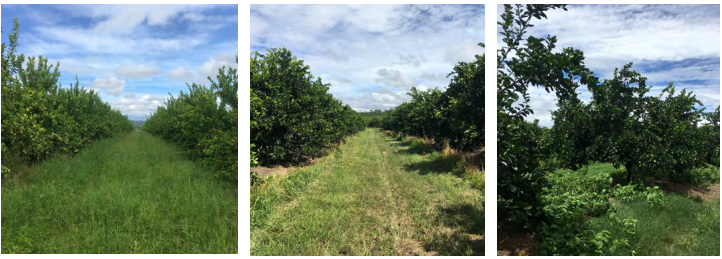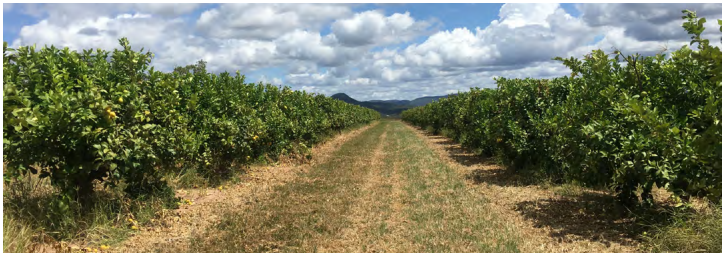05 July 2022
Mitey problems in Far North Queensland
Mitey problems in Far North Queensland
5 July 2022
Mites are the biggest pest for citrus growers on the Atherton Tablelands in Far North Queensland (FNQ). Globally, mites are a difficult pest to manage and there is little information available on how to manage them. To improve understanding of citrus mites in FNQ, staff from the Department of Agriculture and Fisheries in Mareeba took a closer look at the pests during the last mite season (September 2020 to April 2021). Here is what they found.
The oriental spider mite, Eutetranychus orientalis, was the most dominant mite species in five out of eight months of the study. Rust mites were the dominant species from January to March. Rust mites included mostly the citrus rust mite, Phyllocoptruta oleivora, and small numbers of Brown citrus rust mite, Tegolophus australis. Broad mites, Polyphagotarsonemus latus, were only present in February. (See Figure 1).

Figure 1: Oriental spider mite, rust and broad mites were found throughout the study period from September 2020 to April 2021*.
Mite control was solely based on chemical sprays and no other control methods were specifically used. Traditional miticides were the most commonly used products, including sulphur, abamectin, etoxazole and fenbutatin oxide. There was also regular use of broad spectrum insecticides, such as chlorpyrifos and methomyl. Overuse of broad spectrum insecticides is known to flare mites and destroy natural enemies. Activators, adjuvants, wetters and mineral oils were also used to increase the effectiveness of spray products against mites. Mineral oils also have miticidal activity.
BETTER MITE MANAGEMENT
In addition to quantifying mite populations in FNQ, this study attempted to correlate farm management practices to mite populations. A range of practices have been identified which may improve crop resilience against mites.
#1 Establish habitat for beneficial insects
In the 20-21 FNQ study, lower mite pressure was found on farms with flowering intra-row vegetation (underneath trees), especially broadleaf weeds. This vegetation provides food and shelter for beneficial insects that prey on mites. In addition, it is widely reported that inter-row vegetation (between rows) is also critical habitat for beneficial insects. Management of both areas is difficult; some weeds will harbour pests and disease, and excessive weeds will compete for nutrients and water with the main tree crop. Further research is required to determine most practical intra-row vegetation management to reduce mite infestations.
Best practice tip: Use alternate mowing techniques to provide shelter and food for beneficial insects.

There are a range of intra- and inter-row management options currently used in FNQ. These include leaving rows un-mowed, leaving a strip of grass/weed against the tree row or not spraying under the canopy or between trees at all.
#2 Nitrogen management
Tender, succulent new growth is attractive to mites and excess leaf nitrogen is known to stimulate spider mite populations. In the 20-21 FNQ study, leaf tissue ammonium nitrogen was found to significantly impact mite pressure. Ammonium is a breakdown product from urea and can accumulate as part of naturally occurring nitrogen cycling. These are complex processes which need further investigation in FNQ citrus orchards.
Best practice tip: Take regular soil and leaf samples to assist nitrogen application rate decisions Minimum one test per year.
BETTER PEST MANAGEMENT
A citrus orchard is a complex environment. Mites are only one part of the system. However, every management decision you make on your farm can inherently impact your mite pressure. Here are some more factors to consider.
#3 Effective spraying
Chemicals should be used judiciously in an effective integrated pestmanagement system. Over-spraying with broad spectrum insecticides can flare mites, especially spider mites such as the Oriental Spider mite. Growers need to be cautious of the number of sprays used per season. Sprayers should be calibrated often – at least once per season. This will ensure that each spray is achieving the best rate of kill, which helps avoid the need for multiple applications.
Best practice tip: Avoid sole reliance on chemical control options. Decisions to spray should be based on monitoring results. Avoid calendar spraying. Rotate between chemical groups. Calibrate and check sprayer setup regularly.

Water sensitive paper is a useful tool for checking the coverage of your sprayer.
#4 Minimise plant stress
Stressed trees are likely to be more prone to mite infestation. Good irrigation practices will maintain a healthy orchard which is less prone to stress. Wide throwing sprinkler irrigation will assist in maintaining flowering groundcover in the interrow especially during the dry season. Mulching is key to promoting a healthy soil biodiversity, buffering temperature and water loss, and it provides habitat for beneficial insects.
Best practice tip: Regularly monitor soil moisture to keep levels within the optimum range for your crop and soil type. Where possible, avoid bare earth under trees and between rows.
MITES ARE A CHALLENGING PEST
The results discussed here are preliminary and research is ongoing. Priority research areas include:
- Survey of mite species impacting citrus and their natural predators (predatory mites and others)
- How to best attract and protect predatory mites and beneficial insects in citrus orchards
- Extensive surveys to determine seasonal mite pressure

Grassed inter-rows provide habitat for beneficial insects and prevent excessive dust. A side throw slasher can be used to produce your own mulch.

This work has been funded by the Queensland Department of Agriculture and Fisheries. Special thanks to all farms and pest scouts who assisted with this study. For more information contact: Ebony Faichney, Development Horticulturist, Queensland Department of Agriculture and Fisheries, Mareeba ebony.faichney@daf.qld.gov.au
Membership
You are not logged in
If you are not already a member, please show your support and join Citrus Australia today. Collectively we can make big things happen.
